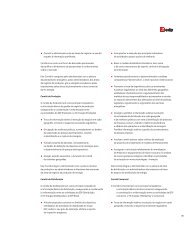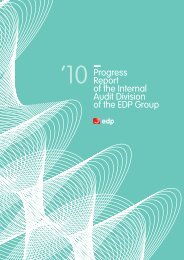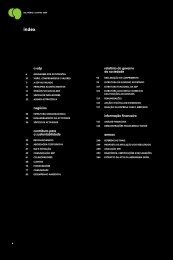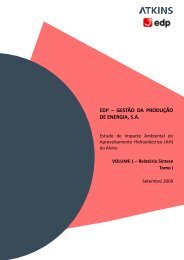Annual Report - EDP
Annual Report - EDP
Annual Report - EDP
- No tags were found...
You also want an ePaper? Increase the reach of your titles
YUMPU automatically turns print PDFs into web optimized ePapers that Google loves.
: corporate governance :unavailability. This risk is mitigated by top-leveloperation methods, maintenance and safetyprocedures. The most important insurable risksare associated with generation, which is coveredby insurance managed by the Insurable RiskManagement Office at <strong>EDP</strong> Valor.Environmental risk - Means of generation aremore vulnerable to this type of risk due to theuse of natural resources, the emissions andwaste that thermoelectric generation causes andthe impact on biodiversity of wind generationand other technologies. The Group has a verystrict environmental policy that is enforcedby an environmental management systemdesigned to meet all the licensing parametersfor facilities and introduce additional measuresto improve performance in this area andmitigate any liabilities. <strong>EDP</strong> has environmentalliability insurance to respond to new Europeanrequirements in this context. For more informationon the company’s environmental performance, seethe section Contribution to Sustainability in thechapter on environmental performance.Credit risk - This risk is not significant on theorganised market and for OTC market operationsand the purchase of fuel, the UNGE minimises itby imposing exposure limits, which are approvedin accordance with counterparties’ ratings(defined by an independent entity or in-house,if there is not outside information).Liquidity risk - This risk arises mainly in hedgingoperations on organised markets. In operationson these markets almost all the counterpartyrisk is mitigated but if margin accounts in thesecontracts or other guarantees are required,with periodic calculation of the market valueof contracts, liquidity needs may arise whilethese financial instruments are in effect. Thismanagement is performed by the UNGE and theFinancial Management Department, which takeout dedicated lines of credit for the purpose.Market supplyElectricity price risk - This risk is managed bythe UNGE and internal prices are defined after thevolume of sales to end users by <strong>EDP</strong> Comercial –Comercialização de Energia, S.A. and HC Energíahave been determined, except in situations whenit is possible for contracts to be indexed to themarket price.Volume risk - The volume of power sold to endusers is always uncertain to some extent, due toweather and economic conditions, the migrationof customers to the free market from the publicand regulated-tariff service or migration fromone free seller to another. As a principle, thisrisk is taken by suppliers, as they will have tomake adjustments for surpluses or shortagesat the market price. However, the transitionphase that the MIBEL is currently going through,which causes considerable uncertainty in theshare of free-market consumption, in view ofthe higher or lower attractiveness of the publictariff and competitive dynamics, requires dynamicmanagement of this risk using periodic, integratedintervention by the Price and Volume Committee,which was set up for the purpose.Operational commercial quality risk - In a freemarket, the criteria for quality of commercialservice are the Group’s full responsibility and ithas set great store by its proper management.Credit risk - This risk, which is associated withsupply, is managed first and foremost on thebasis of contractual criteria and secondly by<strong>EDP</strong> - Soluções Comerciais S.A. (<strong>EDP</strong> SoluçõesComerciais), whose responsibility for metering,billing and collection is delegated (in Spain, HCEnergía and Naturgas).<strong>EDP</strong> - <strong>Annual</strong> <strong>Report</strong> 2012Supplier of last resortPursuant to current legislation, consumers thatchoose a regulated-tariff energy supply arecustomers of <strong>EDP</strong> Serviço Universal, the so-calledsupplier of last resort. In Portugal, as of 1 January2011, it only covers the domestic and non-domesticconsumers that have not yet changed to the freemarket and who will have to pay a transition tariffas of 1 January 2013. On 1 January 2013, theregulated tariffs for energy sold to domestic endusers were abolished and so new customers willhave to choose a free market operator. Customersthat still pay the regulated tariff have a transitionperiod to change to the liberalised market and theirconsumption is subject to a transition tariff fixedby the ERSE and revised periodically.Regulatory risk - This is a low-risk activity.Nonetheless, deviations from forecasts made bythe regulator, Entidade Reguladora dos ServiçosEnergéticos, of power purchase costs and theresulting high deficit or surplus cause concern asto the fair remuneration of this volatility. We hopethat the ongoing elimination of regulated tariffs onthe sale of electricity will improve the competitivebalance mechanisms and more closely followchanges in international costs of raw materialsneeded to generate electricity.Operational commercial quality risk - Irrespectiveof the criteria set out for quality of commercialservice (e.g. average response time for servicesprovided to customers, percentage of readingsof low-voltage meters), the Group has committedsubstantially to management of this risk, as theyhave considerable impacts on management of thebrand erosion risk.Credit risk - Management of this risk is delegatedto <strong>EDP</strong> Soluções Comerciais and abides by theregulations on public service customers (supplycut after payment deadlines have expired).Electricity distributionRegulatory risk - Changes in the rules on theremuneration of this activity may affect theearnings of <strong>EDP</strong> Distribuição – Energia, S.A.and HC Energía. In addition to fair defence ofthe valuation criteria of the activity, the Groupalso seeks to follow best practices in planning,construction, operation and maintenance of gridsand achieve or, if possible, exceed the gains inefficiency set out in the regulatory goals.Operational risk of losses and technicalquality of service - Irrespective of the criteriaset out for quality of technical service (e.g.duration and number of service interruptions,service restoration time) and incentives toreduce physical losses in the grid, the Grouphas committed substantially to management ofthis risk as there are considerable impacts onmanagement of the risk of brand erosion andefficient energy management policy.Operational grid operation risk - The existenceof infrastructures in the public domain (e.g. lines,cables, and transformer stations) may increasethe impact of breakdowns and incidents. This riskis mitigated by means of conduction methods,maintenance and safety procedures in line withthe highest international standards. Nonetheless,extreme, uncommon weather conditions haveresulted in supply cuts and substantial,newsworthy damage. Our response to this typeof crisis has improved significantly. Insurablerisks are covered by insurance.Environmental risk - Although it is lessimportant that in electricity generation, it isworth mentioning the problem of the relationshipbetween overhead lines and birdlife and theenvironment and also their visual impact. Careful121
















